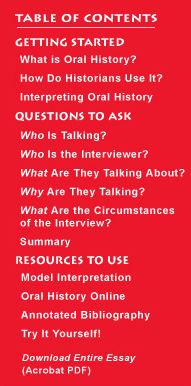talking history | syllabi | students | teachers | puzzle | about us

|
There is no doubt that the single most important factor in the constitution of an interview is the questions posed by the interviewer. Inevitably derived from a set of assumptions about what is historically important, the interviewer's questions provide the intellectual framework for the interview and give it direction and shape. For especially articulate narrators, the questions are a foil against which they define their experience. Good interviewers listen carefully and attempt to more closely align their questions with what the narrator thinks is important. Nonetheless, more than one interviewer has had the experience described by Thomas Dublin as he reflected upon his interviews with coal mining families: "Once, when looking over photographs with Tom and Ella Strohl [whom he had previously interviewed], I expressed surprise at seeing so many pictures taken on hunting trips with his buddies. When I commented that I had not realized how important hunting had been in Tommy's life, he responded good-naturedly, 'Well, you never asked.'"* Yet the
questions asked are not the only influence an interviewer has upon what
is said in an interview. Like narrators, interviewers have social identities
that are played out in the dynamic of the interview. Narrators assess
interviewers, deciding what they can appropriately say to this person,
what they must say, and what they should not say. Thus a grandparent
being interviewed by a grandchild for a family history project may well
suppress less savory aspects of the past in an effort to shield the
child, serve as a responsible role model, and preserve family myths.
And I described above how my own social identity as the upwardly mobile
granddaughter of Polish immigrants created a particular emotional subtext
to interviews with Polish cannery workers. Source for exercise drawn from James W. Davidson and Mark H. Lytle, After the Fact: The Art of Historical Detection (1985), 183-193.
|
|||||||

|
||||||||


